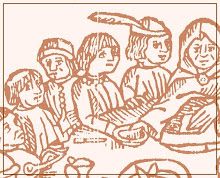A brief chronicle arranged by year from 1066 to 1304, extended to 1314 in another hand, with a later addition in a third.
Description.
Vellum, quarto (Hardy 352), 4 ff. Brereton mistakenly includes this manuscript and the following to f. 88 in her foliation of the Liber Alani de Ashbourne (see previous post), suggesting that it resembles those manuscripts at least superficially in layout, script and quality of parchment.
Contents.
A brief chronicle with three different periods of authorship. Incipit “Anno ab Incarnatione millesimo sexagesimo sexto”; explicit “In die nativitatis ejusdem Johannis” Baptistae (qtd. in Hardy 352).
Date.
According to Hardy, it imitates the Chronicle of Wigmore to 1279 (though scantily), then continues independently to 1304, where the first hand ends. The second hand continues through to 1314, while a single entry in a third hand notes the truce between France and England in 1341 (352).
Origin, authorship, later provenance.
The nature of the chronicle and the multiple authorship suggest a religious house. Hardy notes that local references would suggest Gloucester or nearby Wales, with influence from Wigmore, Herefordshire (Hardy 352). As Sir John Prise was very active in the dissolution of the religious houses in Gloucestershire, and had a penchant for collecting chronicles (Ker, Sir John Prise 5), it is possible it passed directly into his hands in 1535 or 1539, and thence to Cotton by a similar path to the South English Legendary fragment.
Lacunae and potential.
The brevity and imitative quality of this chronicle leave few clues as to its history, and have drawn it little attention from those scholars who have studied the manuscript. It sits, quiet and unassuming, in approximately the middle of the codex, least remarked of all. However, it is perhaps this very unremarkable nature that makes it valuable. A comparison with the Lichfield and Fineshade chronicles, together with some of the many other small-scale monastic chronicles by religious houses around this period, has the potential to establish a valuable pattern against which to judge impulses of conformity and diversity, inspiration and influence, in historical writing of the day.
Cited.
Brereton, Georgine E. (ed). Des grantz geanz: An Anglo-Norman poem. Oxford: Medium Ævum 1937.
Hardy, T. Duffus. Descriptive catalogue of materials relating to the history of Great Britain and Ireland v. 3. London: Rolls Series 1871.
Ker, Neil R. “Sir John Prise”, Library, fifth series, 10 (1955): 1-24.


.jpg)


No comments:
Post a Comment